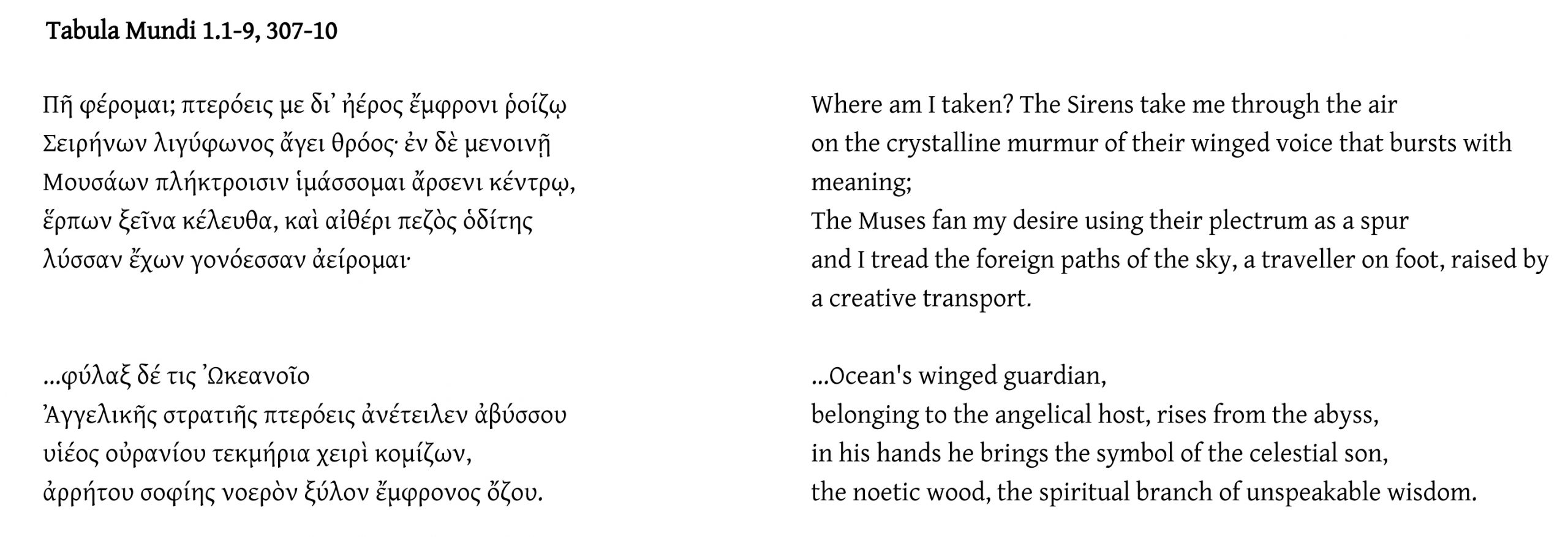John of Gaza
(fl. 550)
This poet lived between the time of Anastasius and that of Justinian and belongs to the famous School of Gaza. As Wear (2013) mentions, it was not only a school of rhetoric, as in the case of Procopius, Coricius and other figures, but also of philosophy, and as such a branch of the great School of Alexandria, with important Christian members who were educated in the platonic Vulgata. John is, above all, a follower of Nonnus’ descriptive and allusive style, but it is obvious that he also received a careful philosophical education. He is the clearest example of a Neoplatonic allegorist among the Greek authors represented here.
His ekphrasis tou kosmikou pinakos or ‘description of the cosmological ceiling frescoes’ in the baths of Gaza shows a fascinating compilation of classical motifs with allusions to the theological discussions of his time, such as the Monophysite controversy. The text and critical apparatus of the old edition by Friedländer (1912) and the recent ones by Lauritzen (2015) and Gigli (2021) show a profound Nonnian influence, to the extent that the work has even been qualified as a cento or patchwork of Nonnus. A perusal of the text shows the clear presence of Neoplatonic vocabulary, epithets, and formulas in John’s allegorical interpretation of the cosmos as a Tabula mundi, as well as in his description of the abstract characters that populate it (1.87-95). It goes without saying that we are far from the traditional Greek ekphrasis, and this precisely because of his insistence on the aesthetic experience as a path that leads to the contemplation of the divine. Underlining the Neoplatonic background of this poet, Daria Gigli (2014) finds in his verses the πόνος (‘toil’) of the surrender to beauty of Plato’s Symposium (212a) and evidence of the pains that the human soul suffers in the unio mystica with the One, as seen by Plotinus.

For searchable text page – click here
Source
D. Gigli (2011), ‘John of Gaza and the Late Antique Greek Ekphrastic Poetry’, in David Hernández de la Fuente (ed.), New Perspectives on Late Antiquity (Newcastle, Cambridge Scholars), 288-304.

For searchable text page – click here
Source
Gigli Piccardi, D. (2014), ‘Poetic Inspiration in John of Gaza: Emotional Upheaval and Ecstasy in a Neoplatonic Poet’, in K. Spanoudakis (ed.) (2014) Nonnus of Panopolis in Context: Poetry and Cultural Milieu in Late Antiquity with a Section on Nonnus and the Modern World (Berlin/Boston, Walter De Gruyter), 403-20.
References
Friedländer, P. (1912), Johannes von Gaza und Paulus Silentiarius: Kunstbeschreibungen Justinianischer Zeit (Leipzig, Teubner).
Gigli, D. (2014), ‘Poetic Inspiration in John of Gaza: Emotional Upheaval and Ecstasy in a Neoplatonic Poet’, in K. Spanoudakis (ed.), Nonnus of Panopolis in Context: Poetry and Cultural Milieu in Late Antiquity with a Section on Nonnus and the Modern World (Berlin/Boston, Walter De Gruyter), 403-420.
Gigli, D. (2021), Giovanni Di Gaza, Tabula mundi. Edizione critica (Alessandria, Edizioni dell’Orso).
Lauritzen, D. (2015) Jean de Gaza, Description du tableau cosmique (Paris, Les Belles Lettres).